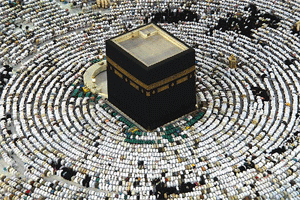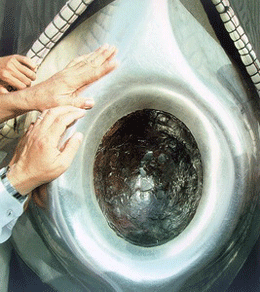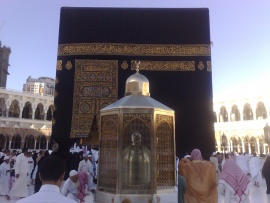
The ka’bah is the direction towards Muslims from all over the globe pray towards. Allah (swa) says in the Qur’an:
“Indeed We see the turning of your face to heaven, so We shall surely turn you to a qiblah which you shall like; turn then your face towards the Sacred Mosque, and wherever you are, turn your face towards it.” [2:144]
There are several names for the ka’bah, they are al-Ka‘bah, Bayt al-Harām, Baytullāh, al-Bayt al-Atīq and Qiblah. In verse 2:125, Allah Almighty addresses the Ka‘bah as “My House”.
Allah (SWT) says,
“Verily, the first House (of worship) appointed for mankind was that at Bakkah (Makkah), full of blessing, and a guidance for Al-‘Alamin (mankind and jinns). (Al-‘Imran 3:96)
Its is the shape of a cube and is covered with a black cloth, called ‘kiswa’. It is replaced every year. It has gold qur’anic embroidery hand written on the cloth. The ‘kiswa’ is made in a special factory designed and costs approx. 17million Saudi riyals. The total area of the cloth is 658sqr meter.
The ka’bah is 39 feet 6 inches high. It measures 13m by 9m inside, and the walls are 1m wide.
Dr. Muzammil Siddiqi is the president of the Islamic Society of North America (ISNA). He had the opportunity to go inside the Kaba in October 1998. In an interview with Sound Vision, he described the following features:
- there are two pillars inside (others report 3 pillars)
- there is a table on the side to put items like perfume
- there are two lantern-type lamps hanging from the ceiling
- the space can accommodate about 50 people
- there are no electric lights inside
- the walls and the floors are of the marble
- there are no windows inside
- there is only one door
- the upper inside walls of the Ka’ba were covered with some kind of curtain with the shahadah written on it.
 At the corner of the ka’bah is the ‘hajr aswad’ (the black stone). The Messenger (saw) said: “Nothing of Jannah remains (in this world) except the Hajr-e-Aswad. If it was not for it being polluted by the filth and impurities of the idolaters, then no ill people would have touched it seeking a cure for an ailment except that they would have been cured.” (Muatta)
At the corner of the ka’bah is the ‘hajr aswad’ (the black stone). The Messenger (saw) said: “Nothing of Jannah remains (in this world) except the Hajr-e-Aswad. If it was not for it being polluted by the filth and impurities of the idolaters, then no ill people would have touched it seeking a cure for an ailment except that they would have been cured.” (Muatta)
By facing or kissing this sacred stone, the tawaf begins and ends. Narrated ‘Abis bin Rabia: Umar came near the Black Stone and kissed it and said, “No doubt, I know that you are a stone and can neither benefit anyone nor harm anyone. Had I not seen God’s Apostle kissing you, I would not have kissed you. [Al Bukhari and Al Muslim]
The Black Stone was sent down by Allah (swa) to this earth from Paradise.
It was narrated that Ibn ‘Abbaas said: The Messenger of Allaah (saw) said: “The Black Stone came down from Paradise.” [At Tirmidhi, al-Nasaa'i ]
The Stone was initially white, but it turned black over time.
It was narrated that Ibn ‘Abbaas said: “The Messenger of Allah (saw) said: ‘When the Black Stone came down from Paradise, it was whiter than milk, but the sins of the sons of Adam made it black.’” [At Tirmidhi, Ahmad ]
During the time of the Quraish, before prophethood, the flood damaged the ka’bah, and thus the Quraish rebuilt it. The Quraish had insufficient funds to rebuild the whole ka’bah, so a small wall was built showing the boundaries of the original foundation laid by Ibraheem (as). When the time for replacing the black stone appeared, a dispute broke out. Every chieftain wanted the honor of replacing the stone. Abu Umayya, the eldest among them, suggested that the next man to enter the haram should be given authority to decide. It so happened that Muhammad (saw) was the one to enter first, and he (saw) settled the dispute placing the black stone in a sheet, and asking each chieftain to hold the corner of the sheet. Then Muhammad (saw), with his own hands placed the black stone in its rightful place. The door of the ka’bah was not lowered, so that no one would enter it. The doubled the height of the walls, added a roof on the Ka‘bah and the water outlet.
 The Maqam-i Ibraheem refers to the blessed stone which was brought by Isma’eel (as) for his father Ibraheem (as) to stand on, while building the wall of the Ka‘bah. Allah (swt) caused the trace of his footprints to remain on the stone as a reminder to the believers among his descendants. The greatest virtue of the Maqam-i Ibraheem is that Allah has instructed Muslims to perform the two rakah salah after tawaf, behind it.
The Maqam-i Ibraheem refers to the blessed stone which was brought by Isma’eel (as) for his father Ibraheem (as) to stand on, while building the wall of the Ka‘bah. Allah (swt) caused the trace of his footprints to remain on the stone as a reminder to the believers among his descendants. The greatest virtue of the Maqam-i Ibraheem is that Allah has instructed Muslims to perform the two rakah salah after tawaf, behind it.
Allah says: “And [mention] when We made the House a place of return for the people and [a place of] security. And take, [O believers], from the standing place of Abraham a place of prayer. And We charged Abraham and Ishmael, [saying], “Purify My House for those who perform Tawaf and those who are staying [there] for worship and those who bow and prostrate [in prayer].”
The imprints of Ibraheem’s (as) feet can be seen a glass box, mounted on a platform.
In 64AH, during the rein of Abdullah bin Zubair (ra) the Ka’bah was damaged by fire, when Makkah was under siege from the army of Yazeed-bin-Muawaiya. The ka’bah was rebuilt, according the the original foundations of Ibraheem (as), including in it the area of ‘hateem,’ as narrated by the Messenger of Allah (saw) in a hadeeth. The Prophet (saw) said: “O Aa’isha! Had your people not very recently been in the Period of Ignorance, I would have had the Ka’bah demolished and included the left-out portion within its walls. I would have also brought the inside of the Ka’bah to ground level and added two doors, with one on the eastern wall and the other on the western wall. In this manner, it would be according to the building and foundation of Ibraheem (as).” But during the rein of the Ummayid khalifah, Abdul Malik Ibn Marwan, The ka’bah was changed back to its orginal state, as he had not heard theat particular hadith of the Prophet (saw).
There are many Hadeeth describing the virues of the ka’bah.
The Messenger of Allah (saw) said: “The Ka’bah is surrounded by seventy thousand angels. They seek forgiveness and blessings for those who make tawaf.” (Ibn Majah)
The Messenger of Allah (saw) said: “One who makes tawaf, dives into the mercy of Allah. Allah lauds those who make tawaf in the celestial circles of the angels. ” (Muatta)
“If the angels were to shake hands with anyone, then they would have shaken hands with:
(Al Muslim, Al Bukhari)
On the Day of resurrection, will testify in favour of those who touched it.
It was narrated by Ibn ‘Abbaas that the Messenger of Allah (saw) said concerning the Stone: “By Allah, Allah will bring it forth on the Day of Resurrection, and it will have two eyes with which it will see and a tongue with which it will speak, and it will testify in favour of those who touched it in sincerity.” [At Tirmidhi, ibn Maajah ]
Directly above the Ka’bah, is a corresponding place in the heavens called the Baytul Ma’moor which holds the same status there as the Ka’bah does here on earth. Each day seventy thousand angels engage in worship there and none of them get a second opportunity to present themselves there again. The Baytul Ma’moor is such a sacred and honoured place that Allah (swt) takes an oath on it in the Holy Quran in Surah Toor:
“And I swear by the Baytul Ma’moor.” [4:52]
Abdullah bin Abbas (ra) reports that the Prophet (saw) said: “One hundred and twenty mercies descend upon the Ka’bah every day and night; sixty for those performing tawaf, forty for those engaged in salah and twenty for those who are merely looking at the Ka’bah.” [Bayhaqi]

